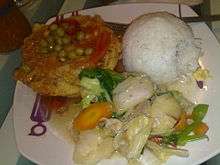Egg foo young
| Egg foo young | |||||||||||
|
Pork Egg Foo Young With Brown Gravy | |||||||||||
| Chinese | 芙蓉蛋 | ||||||||||
|---|---|---|---|---|---|---|---|---|---|---|---|
| |||||||||||
Egg foo young (Chinese: 芙蓉蛋 pinyin = fu2 rong2 dan4; Jyutping: fu4 jung4 daan6*2, also spelled egg fooyung, egg foo yong, or egg fu yung) is an omelette dish found in Chinese Indonesian, British[1] and Chinese American cuisine.[2][3] The name comes from the Cantonese language. Egg foo young is derived from fu yung egg slices, a mainland Chinese recipe from Shanghai.[4]

Preparation
Literally meaning "Hibiscus egg", this dish is prepared with beaten eggs and most often minced ham. It may be made with various vegetables such as bean sprouts, bamboo shoots, sliced cabbage, spring onions, mushrooms and water chestnuts.[5] When meat is used as an ingredient, a choice of roast pork, shrimp, chicken, beef, or lobster may be offered.
In Chinese Indonesian cuisine, it is known as fu yung hai, sometimes spelled as pu yung hai. The omelette is usually made from the mixture of vegetables such as carrots, bean sprouts and cabbages, mixed with meats such as crab meat, shrimp or minced chicken. The dish is served in sweet and sour sauce with peas.
In Western countries, the dish usually appears as a well-folded omelette with the non-egg ingredients embedded in the egg mixture, covered in or served with sauce or gravy. Chinese chefs in the United States, at least as early as the 1930s, created a pancake filled with eggs, vegetables, and meat or seafood.[3] In a U.S. regional variation, many American-Chinese restaurants in St. Louis, Missouri, serve what is called a St. Paul sandwich, which is an egg foo young patty served with mayonnaise, dill pickle, and sometimes lettuce and tomato between two slices of white bread.
In the Netherlands it is known as Foe yong hai, and is nearly invariably served with a sweet tomato sauce.[6]
Comparison
The Vietnamese dish chá trứng hấp is similar to egg foo young.[7]
In Japanese Chinese cuisine, the dish kani-tama (かに玉 or 蟹玉) is similar, using crab meat instead of ham or other meats.
Certain incarnations of the Korean-Chinese dish jjajang bokkeumbap (자장 볶음밥) are similar; in essence the dish consists of jjajang (a dark brown, black bean and meat sauce) and fried rice, with an optional fried egg or egg-foo-young-like omelet atop the rice.
In Malay cuisine, it is similar to telur bungkus, which literally means "wrapped egg" (the wrap usually contains chicken or beef, onions, mushrooms, vegetables, and gravy, wrapped inside the egg)
In Chinese Thai cuisine, this dish is called "Khai Chiao Yat Sai", which literally means "stuffed fried egg". The common recipe uses minced pork and shredded spring onion.
See also
| Wikimedia Commons has media related to Egg foo young. |
References
- ↑ Tang, David (8 January 2006). "Spare ribs, egg foo-yung, chop-suey and plenty of fried rice: how to murder a Chinese". The Daily Telegraph.
- ↑ Luo, Michael (22 September 2004). "As All-American as Egg Foo Yong". New York Times.
- 1 2 Joulwan, Melissa (20 April 2013). "The Egg Foo Yong Story". Well Fed.
- ↑ Parkinson, Rhonda. "Egg Foo Yung - The Chinese Omelet: Elegant Egg Foo Yung is Perfect for Breakfast or a Main Meal". About.com.
- ↑ "Mushroom Egg Foo Yung Recipe". Recidemia. 13 August 2012.
- ↑ Verweij, Annemiek (29 April 2014). "Zelfgemaakte foe yong hai" [Homemade egg foo young]. Keuken Liefde (blog) (in Dutch).
- ↑ "Vietnamese Steamed Egg....". Retrieved 27 August 2016.